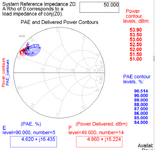Inna89
Newbie level 4
Hello!
I'm doing research in wireless power transfer (WPT). So I need to do load pull analysis for laboratory amplifier EF class in order to find optimal output impedance of it. Because I'm new in it I have a question: how I should choose impedance of source, input power level and Vbias in order to get quality results?

I'm doing research in wireless power transfer (WPT). So I need to do load pull analysis for laboratory amplifier EF class in order to find optimal output impedance of it. Because I'm new in it I have a question: how I should choose impedance of source, input power level and Vbias in order to get quality results?


